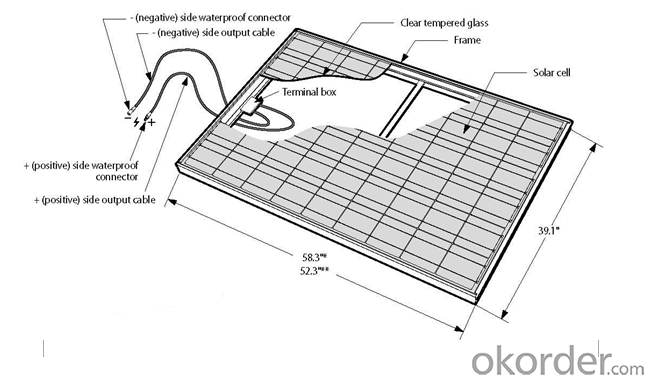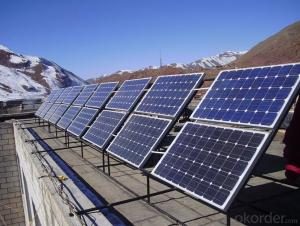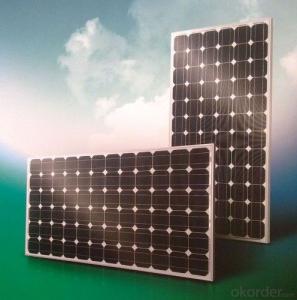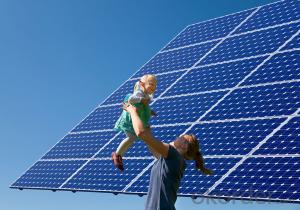(30W) CNBM Solar Monocrystalline 156 Series
- Loading Port:
- China main port
- Payment Terms:
- TT OR LC
- Min Order Qty:
- 100000 watt
- Supply Capability:
- 10000000 watt/month
OKorder Service Pledge
OKorder Financial Service
You Might Also Like
About us
CNBM International Corp, established in 2004, is the business entity for trade and logistic of CNBM Group.With the advantages in Cement, Composite Materials, New Building Materials and Engineering, CNBM mainly concentrate on coal, steel and construction equipments and give priority to solar and wind energy development.CNBM International is highly recognized by its business partners and clients all over the world and has established good business relationship with the customers in over 120 countries and regions all over the world.
Components

Wiring
To ensure proper system operation to maintain your warranty, observe the correct cable connection polarity(Figures 1&2) when connecting the modules to a battery or to other modules. If not connected correctly, the bypass diode could be destroyed.
PV modules can be wired in series to increase voltage. Connect wires from the positive terminal of one module to the negative of the next module. Figure shows modules connected in series .
Data sheet
| Characteristics | |
| Max Power Voltage Vmp (V) | 17.6V |
| Max Power Current Imp (A) | 1.71A |
| Open Circuit Voltage Voc (V) | 22.6V |
| Short Circuit Current Isc (A) | 1.83A |
| Max Power Pm (W) | 30W |
| Temperature Coefficient of Cells | |
| NOCT | 47℃±2℃ |
| Temperature Coefficients of Isc (%/℃) | 0.06% |
| Temperature Coefficients of Voc (%/℃) | -0.32% |
| Temperature Coefficients of Pmp (%/℃) | -0.45% |
| Mechanical Data | |
| Type of Cells (mm) | Mono156×31.2 |
| Dimension | 510×450×25mm |
| Weight | 2.7kg |
| NO.of Cells and Connections | 3×12=36 |
| Limits | |
| Operating Temperature | –45°C to +80°C |
| Storage Temperature | –45°C to +80°C |
| Max System Voltage | 700V |
FAQ:
1. How long will my inquiry get response?
Your inquiry related to our products or prices will be replied within 24 hours.
2. Can I get professional service and suggestion?
Well-trained and experienced staffs to answer all your questions in fluent English.
3. Do you accept OEM or customized design?
OEM & ODM, any your customized lightings we can help you to design and put into product.
4. What if I need specific design?
Distributorship are offered for your unique design and some our current models.
- Q:I've found something called maximum system voltage 000v on my 0 w panel nameplate. Its impossible for 0w to have 000v, right?
- System voltage is the total across the full chain of panels, when using multiple panels in series. It's what the insulation on the panel is rated to stand, to earth/ground, without breaking down. A device could have an output rating of V and still a 000V insulation rating. eg. if your 0W panel had an open-circuit voltage of 25V, the insulation is rated to stand up to 40 panels connected in series. (40 x 25 = 000V). And actually a 0W power source could be rated at 000V, if it's current rating was only 0 milliamps. (Though extremely impractical for a solar panel unit).
- Q:If you were to be asked to write a material(s) report on either -solar panelsor -aircraft fuselageWhich would you choose?well i was asked to choose between these two,so i guess that if i choose what the majority wouldn't, i might just score a little bit higher,what do you think?if you are the lecturer you would want something different right?
- Fuselage, solar panels are boring...check out the design considerations for the fuselage of the old SR-7 Blackbird, a really amazing aircraft in its day.
- Q:Are there any government incentives for installing solar panels?
- Yes, there are various government incentives available for installing solar panels. These incentives can include tax credits, grants, and rebates provided by federal, state, and local governments. These programs aim to promote the adoption of renewable energy sources and help reduce energy costs for homeowners and businesses.
- Q:Is it possible for the everyday person to increase the efficiency of solar panels that they own? If so, how is it done?
- There are 3 (simple) ways to increase the efficiency of a solar panel at home - they all work by increasing the amount of light that falls onto it: . Have the solar panel track the sun throughout the day so that it always faces it; 2. Place a lens (larger than the panel) in front of the panel that focuses the light from the sun onto it. 3. Have mirrors around the panel than redirect light from themselves onto the solar panel. (e.g. imagine a satellite dish with the solar panel at the front and the dish being all mirrored.)
- Q:How are solar panels made?
- Solar panels are made using a complex manufacturing process that involves several key steps. First, high-quality silicon ingots are sliced into ultra-thin wafers. These wafers are then treated with various chemicals to enhance their electrical properties. Next, metal contacts are added to the front and back of the wafers, allowing for the flow of electricity. The wafers are then assembled into a module, encapsulated in a protective layer, and sealed with a glass cover. Finally, the completed solar panels undergo rigorous testing to ensure their efficiency and durability before being ready for installation.
- Q:I was trying to figure out if I could run an electric heater off of a solar panel, but I don't understand these electric convertion factors and stuff. Would it work? (I know it'll only work in the daytime and stuff.)SOLAR PANELPeak Power 95W PTC Watts 73.0WVoc 30.7VPeak Voltage 24.4VIsc 8.6APeak Current 7.96A HEATERInput: 20 V/60 Hz ,500 W/5,200 BTU
- Watts = Volts * Amps Your heater needs at least 500 watts of AC power. The solar panel only produces about 200 watts of power ( 24volts * 8amps). Not enough to run the heater. Also, the solar panel produces DC current, not the AC current that the heater needs. However, if you had solar panel that produced enough power (watts), you could buy a transformer to turn the panel's DC output into the required AC output. But that doesn't seem like a real cost-effective plan.
- Q:I have heard you can make your own solar panels.... But How?Where do you start? Is it cheap, or should I just BUY them already made?
- If you're thinking of solar electric panels then forget it. It you just want to dabble in solar power then shop around for a 5 volt panel. Find out how many watts it puts out and then divide the cost $$ by the wattage. The lower the cost per watt the better of a deal you'll be getting That's generally speaking of course because it doesn't take quality into account but it's a practical way to compare panels. On the other hand, it you want to make a solar panel that will heat hot water then it's a different story. You can have a lot of fun with that project and you'll find a lot of plans on the Internet.
- Q:Can solar panels be used in areas with high humidity?
- Yes, solar panels can be used in areas with high humidity. While high humidity may affect the efficiency of solar panels to some extent, they can still generate electricity. The performance of solar panels in humid environments can be optimized by using materials that are resistant to moisture and by ensuring proper installation and maintenance.
- Q:all i want to do is provide enough electricity for 2 fluorescent bulbs i was looking at some 80 watt panels how many of those would i need and what else do i need for storing the electricity for use at nite? and how much would it all cost?
- The solar panels are made in China because there are fewer environmental regulations and cheap coal power. It takes a lot of energy to melt silicon and there are toxic waste products. It would be three to five times more expensive to make the panels in the US ( three times is just for reprocessing the toxic wastes ). Solar cell made in China are about $2 a watt, perhaps as low as $ a watt but in truth the claims for $ a watt or less solar panels as in thin film solar panels have much lower efficiency and require perhaps ten times more surface area.
- Q:I know that the Solar panels store the power from the sun in the daytime, where does that stored energy go from there? Is it stored in the batteries? And how would you keep the batteries topped up if you had no Electric? by a generator? interested in solar panels for abroad, but need more info.
- Solar panels do not store power. Solar panels convert sunlight into electricity. To store power you need batteries. The usual type of batteries used are lead-acid deep discharge( similar to car batteries). The batteries are charged up during the time the sun is out. However, as a backup you could also have a generator handy to provide power for times when the sun did not shine enough to keep the batteries charged up.
1. Manufacturer Overview |
|
|---|---|
| Location | |
| Year Established | |
| Annual Output Value | |
| Main Markets | |
| Company Certifications | |
2. Manufacturer Certificates |
|
|---|---|
| a) Certification Name | |
| Range | |
| Reference | |
| Validity Period | |
3. Manufacturer Capability |
|
|---|---|
| a)Trade Capacity | |
| Nearest Port | |
| Export Percentage | |
| No.of Employees in Trade Department | |
| Language Spoken: | |
| b)Factory Information | |
| Factory Size: | |
| No. of Production Lines | |
| Contract Manufacturing | |
| Product Price Range | |
Send your message to us
(30W) CNBM Solar Monocrystalline 156 Series
- Loading Port:
- China main port
- Payment Terms:
- TT OR LC
- Min Order Qty:
- 100000 watt
- Supply Capability:
- 10000000 watt/month
OKorder Service Pledge
OKorder Financial Service
Similar products
New products
Hot products
Related keywords





























